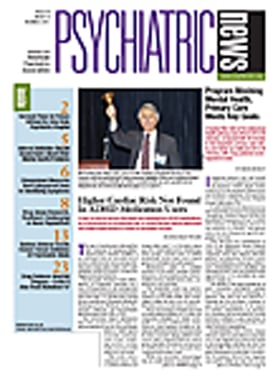Sudden improvement in high-risk suicidal patients challenges the psychiatrist’s clinical acumen and equanimity. A patient admitted for treatment to a hospital is expected to improve. But sudden, unexpected improvement in patients assessed at high risk for suicide poses a dilemma: is it a rapid response to treatment, a decision to die that brings relief, or a deception aimed at rapid discharge? Typically, this conundrum arises on inpatient units, although it also occurs in other clinical settings.
Since many inpatients improve rapidly and are discharged within a few days, the high-risk suicidal patient’s specious improvement can be very difficult and, on occasion, impossible to distinguish from real improvement. Performing systematic suicide-risk assessments is critical. Consultation is prudent.
Many psychiatric inpatients at risk for suicide improve rapidly shortly after admission. Improvement often means that the patient is no longer at acute high risk but has returned to chronic high risk for suicide at discharge, requiring comprehensive discharge planning. Most patients at moderate risk for suicide are treated as outpatients. The structured milieu, the initiation of treatment, the safety measures provided, and the peer interactions can promote rapid improvement. Antianxiety, antipsychotic, and sleep medications can be effective within minutes or hours. A good night’s sleep can result in rapid improvement in the patient’s clinical condition. Apart from medications, psychosocial interventions, especially group therapy, decrease anxiety, reduce isolation, improve reality testing, and provide needed support that shortens the hospital length of stay.
The improving patient usually gives the staff permission to speak to people who know the patient. The treatment team observes whether the patient is adherent to treatment recommendations and conforms to unit policies. The patient displays real improvement by attending group meetings, socializing with other patients, and being visible on the unit.
Most high-risk suicidal patients show gradual, often halting improvement. Real improvement can be rapid but is not usually sudden and unexpected. Basic improvements occur in sleep, appetite, symptom reduction, treatment adherence, and socialization. Real improvement is a process, even when rapid.
The high-risk suicidal patient who feigns improvement by denying suicide ideation, intent, or plan often displays contrary behaviors and attitudes that belie denials. The true intent is to obtain release from the hospital as soon as possible or to wait out a short length of stay, while planning to complete suicide shortly after discharge. Such intentions are facilitated when third-party payers and utilization reviewers apply pressure to psychiatrists for early discharge.
A near lethal suicide attempt or rehearsal usually precedes inpatient admission or occurs on the psychiatric unit. As a measure of the seriousness of the suicide attempt, the patient leaves notes to family members, makes a will, and puts financial matters in order. Some patients admit disappointment at not completing suicide. The patient may display a spectrum of signs—from subtle to overt—that indicate persistent suicidal intent, despite denials. Typical signs include disturbed eating and sleeping patterns that remain unchanged, averted gaze, poor personal hygiene, and disheveled appearance. The patient remains isolated, spending most of the time in the room and is seclusive, with only minimal or superficial contact with the staff and other patients. The patient attends group therapy sporadically or participates minimally or not at all. The patient may withhold permission for contact with significant others.
Little or no therapeutic alliance can be established with the patient. Many psychiatric inpatients, even within a short length of stay, are able to form some therapeutic alliance with the clinical staff or hospital facility. Adherence to medication and to unit rules is tenuous. Medications, when taken, can energize the patient, creating the impression of improvement, but without diminishing underlying hopelessness and suicide intent.
When patients feign being “no longer suicidal,” fundamental changes do not occur in the severity of their clinical condition, behavior, and attitude. Feigned improvement is usually sudden and surprising. It is not a gradual process but an unexpected event that can occur at any point during inpatient hospitalization.

Robert I. Simon, M.D., is a clinical professor of psychiatry at Georgetown University School of Medicine and chair of the Department of Psychiatry at Suburban Hospital in Bethesda, Md. He is the author of Preventing Patient Suicide: Clinical Assessment and Management (American Psychiatric Publishing). The book may be ordered at<www.appi.org/SearchCenter/Pages/SearchDetail.aspx?ItemId=62934> APA members are eligible for a discount.


